Rollator Walkers: When Are They Unsafe? A Comprehensive Guide
This comprehensive guide explores the critical factors that determine who should not use a rollator walker. We look into cognitive and physical prerequisites, specific medical conditions, potential risks like deconditioning, and the importance of professional assessment. You'll also find a comparison with safer alternatives and essential tips for safe operation, helping you make an informed decision about mobility aids.
A rollator walker, with its wheeled frame, hand brakes, and handy seat, is a common sight when it comes to mobility aids. People often get them to boost stability, walk further, and feel more secure, hoping to stay active and independent.
However, there's a critical paradox a lot of clinical evidence and safety data points to: for many, the very device meant to stop falls can actually increase fall risk. It can also lead to physical deconditioning and cause serious injuries if not used correctly. 1 A rollator isn't just any product you pick off a shelf; it's a piece of durable medical equipment (DME). It really needs a formal, evidence-based assessment and prescription from a healthcare professional, like a doctor, physical therapist (PT), or occupational therapist (OT). 5
This report dives deep into the evidence-based reasons why rollators might not be suitable, the risks involved, and safer alternatives. Our goal is to give clinicians, patients, and caregivers the knowledge to make safe, informed choices about mobility.
Key Takeaways: What You Need to Know
- Absolute Contraindications: A rollator is unsafe for individuals who can't bear their full weight (like after a fracture), have severe balance problems, or cognitive issues that stop them from learning and remembering safety steps, such as using the brakes.
- Cognitive Demands: Using a rollator is a mentally demanding dual-task. For those with dementia, delirium, or significant issues with executive function, the risk of falling with a rollator is much higher because the device can divert attention from walking safely. 1
- Physical Requirements: Safe use demands enough upper body strength to control it, good hand and grip strength for the brakes, and the ability to stay upright. A rollator isn't a passive support system; it needs active user engagement. 9
- Not for Weight-Bearing: Rollators are for balance and endurance, not for taking a lot of a user's body weight. If someone has weight-bearing restrictions, a standard (pick-up) walker is the right choice. 9
- Professional Assessment is Crucial: Most people get mobility aids without talking to a healthcare professional, leading to poor fitting and dangerous misuse. 1 A full evaluation by a PT or OT is vital to pick the right device, ensure it fits properly, and provide key safety training.
- Safer Alternatives Exist: For many, other devices like standard walkers, hemi-walkers, quad canes, or specialized walkers (e.g., U-Step for Parkinson's) are safer and more effective because they better match specific functional needs.
Understanding Rollator Walkers: A Quick Primer
A rollator, often called a rolling walker, is a mobility aid known for its three or four large wheels and handlebars with hand-operated brakes. Many also come with a built-in seat and backrest for taking breaks. 12

Unlike a standard walker, which you have to lift and move with each step, a rollator is pushed continuously. This allows for a smoother and faster way of walking. 13
The idea is to help people with heart or lung conditions walk further, give balance support to those with mild to moderate stability issues, and offer a handy spot to rest. 14 However, these very features, the wheels providing easy movement and the brakes needing active use, are also what make it risky if a person's abilities don't match what the device demands.
When a Rollator Is the WRONG Choice: Key Contraindications & High-Risk Groups
Deciding to prescribe a rollator shouldn't just be based on a diagnosis. It needs a thorough functional assessment of the person's cognitive, perceptual, and physical capabilities. A major deficit in any of these areas can make a rollator not just unhelpful, but downright dangerous.
Safe operation requires a combination of skills; if one critical component is lacking, the whole system of safe mobility can fall apart.
Cognitive and Perceptual Impairments: The Brain's Role
The brain's capacity to process information, make sound judgments, and perceive the surroundings is the most crucial, and often overlooked, factor in rollator safety.
The Dementia Paradox: An Aid That Increases Fall Risk
For individuals living with dementia, the data sounds a stark alarm. While these individuals already face a high annual fall risk of 60-80%, using a mobility aid like a rollator is independently linked to a three-fold increased odds of falling . 1 This surprising finding points to a basic mismatch between the device and the user's cognitive abilities.
The reasons for this higher risk are tied to core cognitive problems. People with moderate to severe dementia, delirium, or other acute confusion often can't learn and, importantly, remember safety instructions. They might forget to lock the brakes before trying to sit, causing the rollator to roll away from them. 1
They also show poor judgment when navigating obstacles, lack awareness of their own physical limits, and can't problem-solve when faced with challenges like a narrow doorway or a cluttered path. 1 Clinical studies often use cognitive screening tools like the Mini-Mental State Examination (MMSE) and exclude participants with scores below a certain point (e.g., ≤ 24), highlighting the recognized risk. 17 A thorough cognitive assessment using validated tools like the Montreal Cognitive Assessment (MoCA) or Mini-Cog is therefore essential. 18
The Cognitive Load of Navigation: A Dual-Task Challenge
A rollator isn't a passive support; it's an active tool that needs constant management. This adds a secondary task to the already complex activity of walking, creating a "dual-task" scenario that can overwhelm a compromised brain. 8
Research shows that just using a walker increases cognitive load and worsens gait stability, measured by increased stride time variability, a key predictor of fall risk. 8
Think of it as a competition for limited attention. A healthy person has enough cognitive capacity for both walking and operating the device. But for someone with dementia, a traumatic brain injury, or significant executive dysfunction, the rollator "steals" vital cognitive resources from the main task of maintaining a stable gait.
This results in poorer walking performance, especially in distracting environments or when maneuvering, directly explaining the "dementia paradox". 1
Perceptual Deficits That Obscure Danger
Safe mobility depends on accurately seeing and understanding the environment. Several perceptual problems are strong reasons not to use a rollator:
- Severe Visual Impairment: Individuals who are legally blind, have advanced macular degeneration, or significant visual field cuts (like hemianopia after a stroke) can't reliably spot and avoid obstacles. This makes a wheeled device that can gain momentum extremely hazardous. 20
- Unilateral Spatial Neglect: Often seen after a stroke, this condition means the person isn't aware of one side of their surroundings. They'll consistently fail to navigate around obstacles on their neglected side, leading to inevitable bumps and collisions. 22
- Severe Proprioceptive Loss: A major loss of joint position sense, common in severe peripheral neuropathy, means the body can't sense its position in space. This forces an over-reliance on vision for balance, which isn't enough to manage the dynamic instability of a rolling walker. 20
Significant Physical Limitations: Body Matters
Beyond thinking skills, a user must have a basic level of physical capacity to control a rollator. Lacking this makes the device a liability.
Inability to Bear Full Weight: An Absolute Contraindication
This is perhaps the most critical and clearest reason not to use a rollator. A rollator, with its four wheels, is not designed to support a significant portion of a user's body weight . 9 Its main job is to help with balance.
For any patient with a weight-bearing restriction, like non-weight-bearing (NWB) or partial-weight-bearing (PWB) status after a hip fracture, knee replacement, or other lower limb surgery, a rollator is absolutely contraindicated. Trying to offload weight onto a rollator will cause it to roll away, almost certainly leading to a fall and potential re-injury. 9
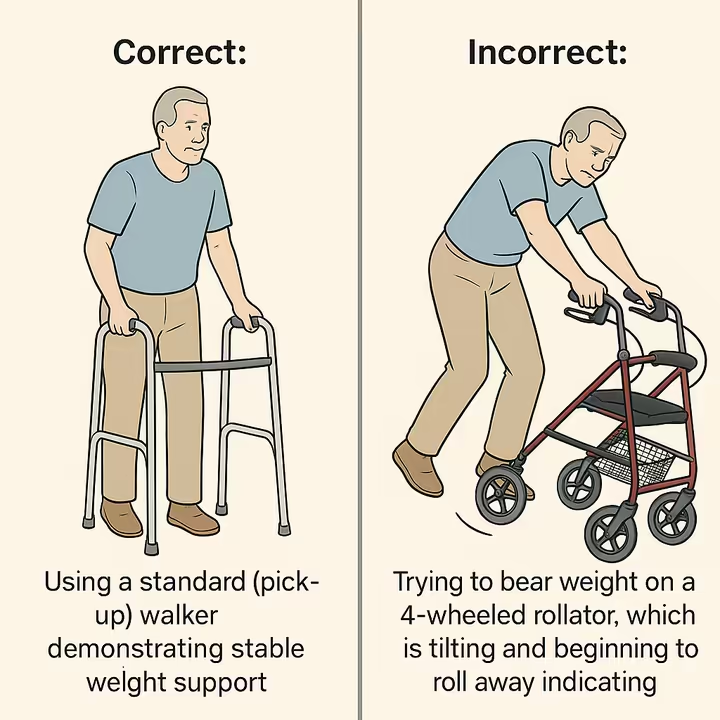
The correct and only safe alternative for these patients is a standard (pick-up) walker . This type of walker provides a fixed, stable base, allowing the user to safely offload weight through their arms. 23
Severe Balance and Coordination Disorders
A rollator user needs some inherent balance to manage it. For those with severe balance problems, the device can easily roll away or veer off course, making them more unstable instead of helping. 9 Conditions that are strong reasons against rollator use include:
- Severe vestibular dysfunction (inner ear balance problems)
- Cerebellar ataxia (lack of muscle control and coordination)
- Uncontrolled vertigo (severe dizziness)
- Severe, symptomatic orthostatic hypotension causing frequent pre-syncope (feeling like you're about to faint when standing up)
These disorders can cause sudden, unpredictable, and large losses of balance that a rollator can't prevent and might even worsen.
Insufficient Upper Body and Grip Strength
Safely using a rollator depends on being able to operate the brakes. This is more than just raw strength; it's about matching the user's hand function to the right type of brake.
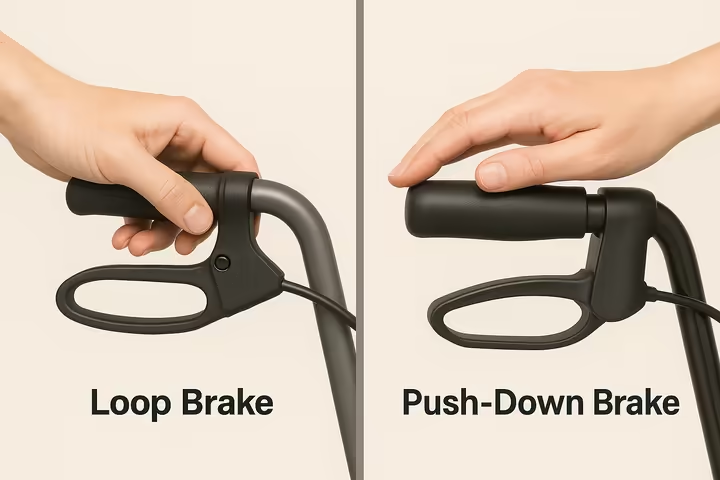
- Brake Mechanisms: Most rollators use either loop brakes (squeeze like bicycle brakes) or push-down brakes (press down on handles). 24
- Matching User to Brake: Someone with painful hand arthritis might struggle with a loop brake but could use their palm on a push-down brake. Conversely, a very frail person might lack the strength for a push-down system but could manage a light loop brake. A clinician must specifically assess this match.
- General Strength: Beyond hands, the user needs enough arm, shoulder, and core strength to steer, control it on slopes, navigate curbs, and lift it (rollators often weigh 14-25 lbs). 9
Prescribing a rollator without confirming the user can reliably and quickly operate its brakes is a major safety oversight. Functional tests (e.g., "Can you squeeze this?"), grip strength measurement, and simple questions ("Can you open a jar without pain?") are key parts of the assessment. 9
Unilateral Upper Extremity Impairment: One-Arm Challenges
A rollator needs two hands for safe steering and braking. So, it's not suitable for individuals who only have functional use of one arm.
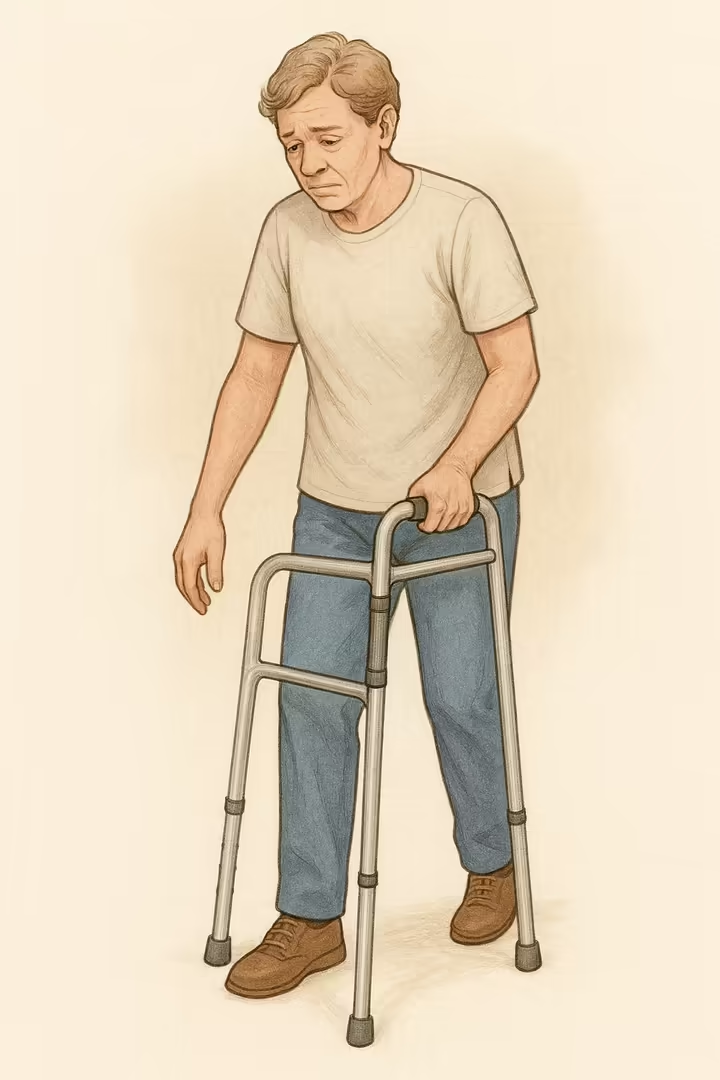
- Post-Stroke Hemiparesis/Hemiplegia: A person with one-sided weakness or paralysis can't safely operate a rollator. The right device is usually a hemi-walker or a large-base quad cane , designed for one-handed use. 22
- Other Conditions: A non-weight-bearing wrist fracture or severe unilateral arm amputation also rules out rollator use. For a wrist injury, a platform walker , supporting the forearm, might be an option. 28
Specific Medical Conditions That May Preclude Safe Use
Certain medical conditions bring unique challenges that make standard rollators a poor, and often dangerous, choice.
Advanced Parkinson's Disease (PD) and Freezing of Gait
While some studies suggest rollators can help some people with Parkinson's Disease (PD) 17 , they're often not suitable for those with advanced symptoms, especially Freezing of Gait (FOG) .
FOG is when someone suddenly can't step forward, often triggered by turning, starting to walk, or navigating narrow spaces. 29 When FOG happens, the user's feet feel "glued to the floor." If they're using a standard rollator, their upper body and the device keep moving forward, creating a high risk of falling forward over the walker. 29 For this reason, experts and clinical guidelines often advise against standard rollators for patients with significant FOG or postural instability. 32
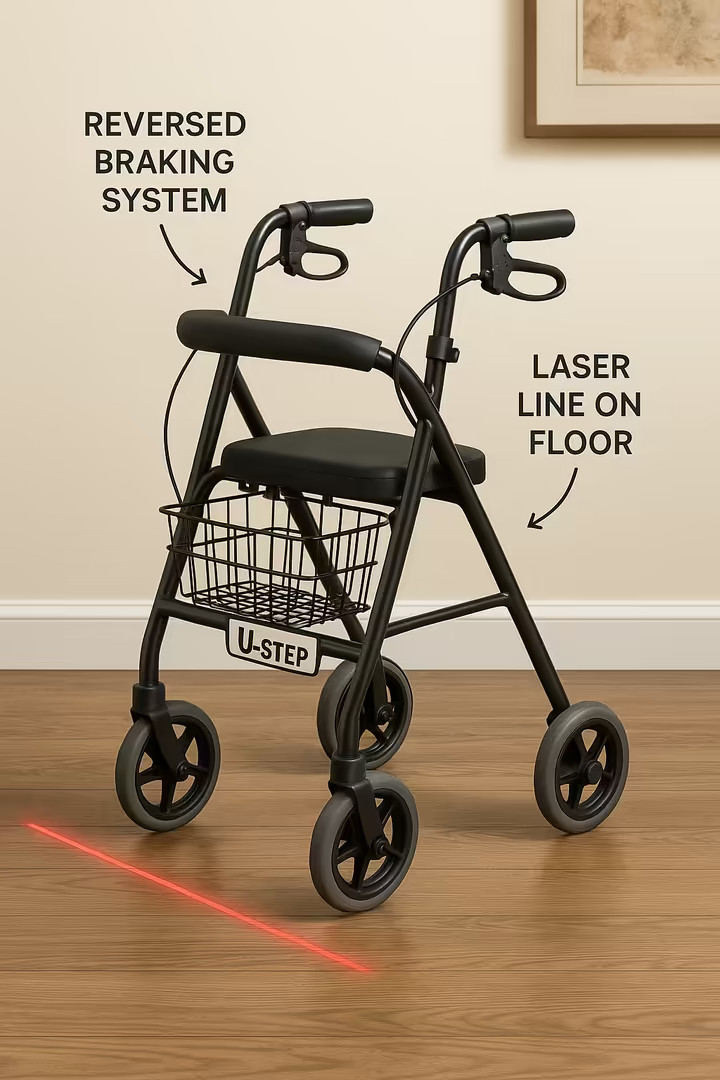
A safer alternative is the U-Step walker , a specialized device for parkinsonian gait. It has a reversed braking system (squeeze to move) and provides visual (laser line) and auditory (metronome) cues to help overcome freezing. 17
Unstable Cardiovascular Conditions
The effort of walking, even with a rollator, can be risky for individuals with unstable heart disease.
- Severe Heart Failure (NYHA Class III-IV) and Unstable Angina: These conditions often exclude people from clinical trials involving exercise. 33 The physical stress of walking could trigger an acute cardiac event. Using any mobility aid for walking in these cases needs explicit clearance from a cardiologist.
- Severe, Symptomatic Orthostatic Hypotension (OH): This involves a sharp blood pressure drop on standing, causing dizziness, lightheadedness, or fainting. 36 While a rollator with a seat is sometimes suggested for patients with managed OH to sit down quickly 38 , it's dangerous for those with uncontrolled symptoms. A user experiencing a sudden, severe drop in blood pressure might not have time or clarity to safely use the brakes and sit before losing consciousness.
Special Populations Requiring Caution
Considerations for Pediatric Use
The term "walker" in pediatrics needs careful definition. Standard "baby walkers" (where an infant sits inside a frame) are widely condemned by pediatric groups as dangerous and bad for development, linked to falls down stairs, burns, and poisonings. 39
For children with disabilities, the choice is usually between a pediatric walker/rollator and a gait trainer .

- Pediatric Walkers/Rollators: These suit children who can stand and step but need support for balance or due to weakness (e.g., some forms of cerebral palsy, GMFCS levels II-III). 41 They can be anterior (pushed in front) or posterior (pulled from behind), with posterior models often preferred for better posture.
- Gait Trainers: These are more supportive for children with significant impairments who lack independent trunk or pelvic control and can't stay upright against gravity. They have straps and supports for the postural stability needed for walking. 43
The main deciding factor is the child's postural control. Key reasons not to prescribe any supportive walking device for children include lack of head control, significant pain during use, active hip dislocation, and severe, fixed skeletal deformities. 44
Challenges for the Very Frail Elderly
For extremely frail older adults with multiple health issues, the combined physical and cognitive demands of safely using a rollator might be too much.
The risk of the device rolling away, plus an inability to react quickly, can make a more stable device like a 2-wheeled or standard walker a safer, though slower, option. A full geriatric and functional assessment is crucial.
Potential Downsides and Risks of Rollator Use
Even for people who meet the basic criteria, rollators aren't risk-free. Chronic misuse can lead to negative functional outcomes, and the device's design has inherent limitations.
The Risk of Deconditioning: Can a Rollator Weaken Muscles?
While a rollator itself doesn't cause weakness, chronic misuse can start a negative biomechanical cycle leading to deconditioning and dependence. This is a direct example of the "use it or lose it" principle.
It often starts with an improper fit or use, commonly adopting a stooped, "forward-leaning posture" by pushing the rollator too far ahead. 2 This unhealthy posture fundamentally changes walking biomechanics. Studies show it leads to increased forward trunk flexion, more hip flexion, and less knee extension during the stance phase of walking. 46
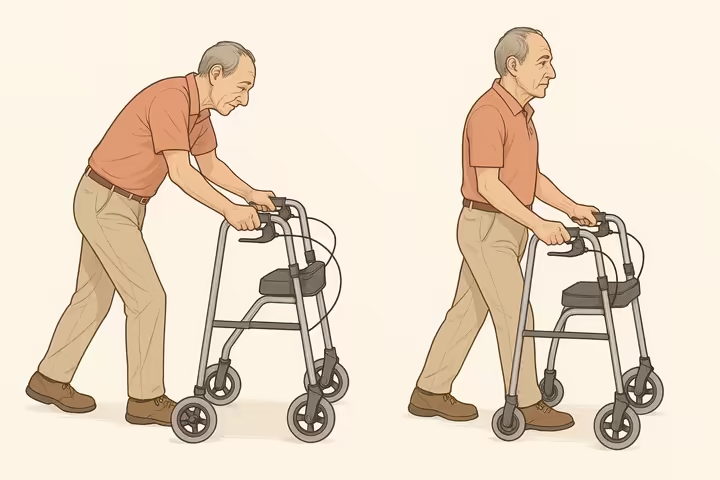
This altered movement pattern results in a documented reduction in quadriceps muscle use and under-activation of core and back extensor muscles vital for upright posture. 46 Over time, this chronic under-loading causes disuse atrophy and weakness in these key muscle groups. 48
As the user's leg and core muscles weaken, they feel less stable trying to walk without the device, reinforcing both physical and psychological dependence. The very device meant to aid mobility can, through misuse, undermine the muscles needed for unassisted walking. This highlights why professional fitting and gait training are absolutely necessary to ensure the rollator is used to maintain proper posture, not as a crutch encouraging a bad one.
Furthermore, long-term use can strain the upper limbs, potentially causing secondary injuries like carpal tunnel syndrome. 49
Inherent Disadvantages and Limitations of Rollators
Beyond user-specific risks, a rollator's design presents several practical challenges that can make it unsuitable for certain people and environments:
- Environmental Mismatches: Rollators are often bulky and hard to maneuver in tight home spaces like narrow hallways, cluttered rooms, and small bathrooms. 1
- Terrain Challenges: They don't do well on very uneven outdoor surfaces, thick carpeting, or gravel, where wheels can get stuck. 51 They are extremely dangerous on stairs and should never be used to go up or down them. 53
- Instability on Slopes: On inclines or declines, a rollator can easily roll away if the brakes aren't applied correctly, posing a major fall risk. 53
- Cost: As more complex equipment, rollators are pricier than standard walkers or canes. 14
For those living in environments with these challenges, a rollator's disadvantages might outweigh its benefits. A simpler device like a 2-wheeled walker or quad cane could be a more practical and safer choice.
Rollator Mechanics and Safe Operation Essentials
Understanding a rollator's mechanical features and safe operation principles is key to reducing risk. This knowledge is vital for clinicians who prescribe them and for users and caregivers managing them daily.
The Brake System: Your First Line of Safety
The braking system is a rollator's most critical safety feature, but it's also a common point of failure and misuse.
- Brake Types and Mechanics: The two most common types are loop brakes and push-down brakes . 24 Loop brakes work like bicycle brakes: squeeze the loop lever up toward the handle to slow down, and push the lever down until it clicks to lock the wheels for parking. 25 Push-down brakes are part of the handlebars; apply downward pressure on the handles to engage them, with more pressure locking them. 25 The choice depends on hand strength and dexterity, as discussed in section 2.2.3.
- Required Hand Function: Safe use needs not only enough grip strength for the brakes but also the motor control and reaction time to apply them quickly if something unexpected happens. 9
- Maintenance and Adjustment: Brakes need regular upkeep. Brake cables can stretch over time, becoming loose and unresponsive. 25 Users or caregivers should know how to check brake pads for wear and adjust cable tension, usually by turning a screw or nut where the cable enters the brake housing. 56 Neglecting brake maintenance can lead to accidents, as seen in FDA adverse event reports. 58
Using the Seat Safely (and When Not To)
The built-in seat is a key feature for users with low endurance, but it's also a major risk source if used improperly.
- Contraindication for Transport: A rollator must never be used as a transport wheelchair (i.e., someone pushing the user while seated). 59 The frame, wheels, and brakes aren't designed for these forces, and this misuse creates a severe tipping hazard.
- Weight Capacity: Every rollator has a specified weight limit for both user and seat, which must be followed. 45
- Safe Transfer Technique: These steps are critical for safety:
- Position the rollator on a flat, level surface. Avoid slopes. 53
- Lock the brakes. The wheels must be fully locked before trying to sit. 53
- Turn around and back up to the seat until your legs touch it.
- Reach back for the seat and lower yourself down carefully.
- To stand up, push up from the seat using your hands and legs. Never pull up on the rollator handles. This action shifts your center of gravity backward and can easily tip the rollator. 53
Proper Usage, Training, and Avoiding Common Misuse
The vast majority of older adults get mobility aids without any professional guidance, leading to widespread and dangerous misuse. 1 Professional training from a PT or OT is essential to build safe habits.
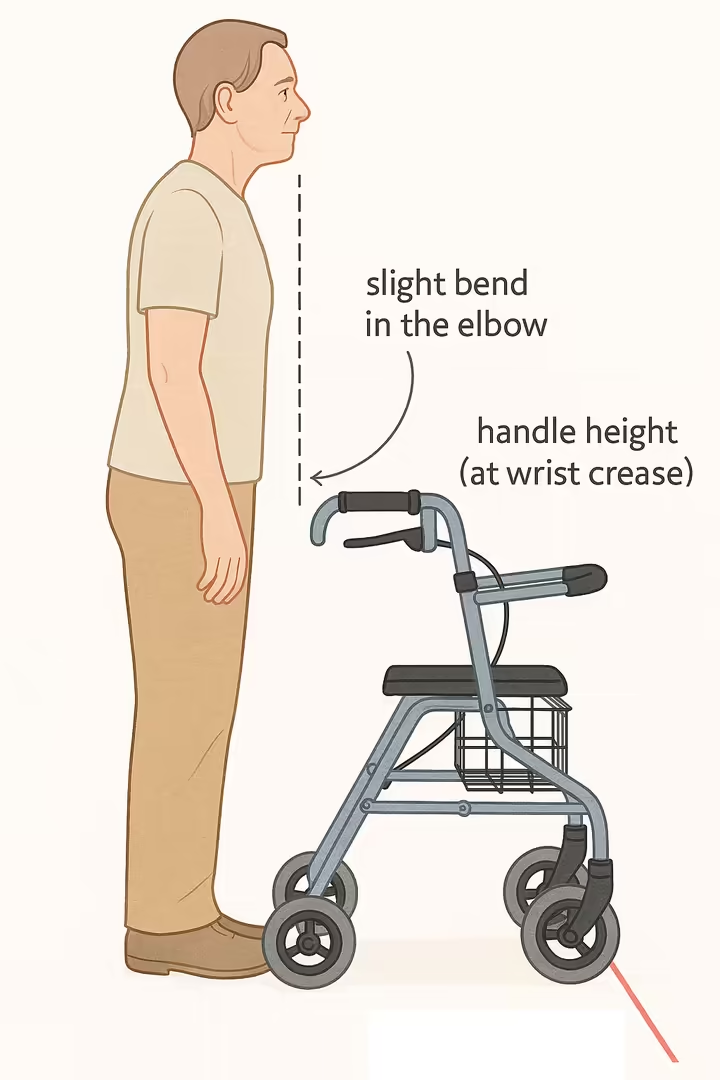
- Height Adjustment: Rollator handles should be at the height of the user's wrist crease when their arm hangs relaxed at their side. This creates a slight elbow bend (about 15-20 degrees) when gripping, promoting an upright posture. 53 Handles too high cause shoulder shrugging; too low encourages stooping. 60
- Gait Pattern: The user should walk inside the frame, body aligned between the rear wheels, not trailing behind and pushing the rollator far ahead. 53 This maintains upright posture and keeps the user's center of gravity within the device's support base.
- Turning: Make turns with a series of small steps, creating a wide arc, not a sharp pivot. Twisting the body away from the rollator during a turn can lead to a loss of balance. 61
- Navigating Curbs: To go up a curb, tilt the rollator back to lift front wheels onto the curb, then lift and roll back wheels up. To go down, lower the rollator first, then step down. Use brakes for control throughout. 53
Environmental and Situational Hazards to Consider
A rollator that's fine in a controlled clinic might become unsafe in a person's home or community. An environmental check is a key part of any mobility aid prescription.
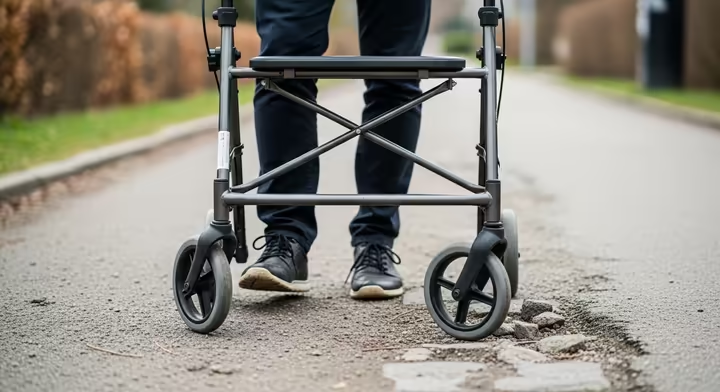
- Unsuitable Home Environments: Homes with many stairs, narrow cluttered hallways, tight corners, or thick, high-pile carpeting can make rollator use impractical and hazardous. 1 The device's width might not fit through standard bathroom doors.
- Challenging Outdoor Terrain: Rollators aren't for very uneven ground, soft surfaces like sand or gravel, or steep slopes. 51 Small wheels can get caught in cracks, and the device can become unstable.
- Adverse Weather: Rain, ice, and snow make surfaces slippery and increase the risk of the rollator sliding uncontrollably, posing a significant danger. 21
- Temporary Unsuitability: A rollator might be temporarily inappropriate during an acute illness, right after certain surgeries, or when on new meds causing dizziness or confusion. A user's suitability can change, needing ongoing checks.
Comparing Alternatives: When Other Mobility Aids Are Better
A core part of safe prescription is knowing when to choose an alternative. These comparisons highlight when a rollator isn't the best choice.
Rollators vs. Standard Walkers (Including 2-Wheeled)
The main difference between a rollator and a standard walker is the trade-off between easy movement and stability.
- Stability: A standard (pick-up) walker offers the most stability because all four legs stay fixed on the ground during weight-bearing. 23 This makes it essential for those with weight-bearing restrictions or severe balance deficits . 9
- Gait and Energy Expenditure: A rollator allows a faster, more continuous, natural gait with lower energy use than a standard walker, which must be lifted and moved with every step, disrupting walking rhythm. 63
- 2-Wheeled Walkers: These devices, sometimes called hybrid walkers, offer a middle ground. With front wheels and stationary back posts, they give more stability than a rollator but a smoother gait than a standard walker. 23 They're often good for those needing some weight-bearing support but struggling to lift a standard walker.
- Cognitive Demands: For individuals with significant cognitive impairment, the built-in stability of a standard or 2-wheeled walker (which can't roll away) makes it much safer than a rollator. 1
The following table provides a decision-making framework for clinicians and users.
Table 1: Mobility Aid Selection Matrix
| User Characteristic | Standard (Pick-up) Walker | 2-Wheeled Walker | 4-Wheeled Rollator | Hemi-Walker / Quad Cane |
|---|---|---|---|---|
| Weight-Bearing Status | Optimal for NWB/PWB 9 | Suitable for PWB/TTWB | Contraindicated 11 | Suitable for mild offloading |
| Balance Impairment | Optimal for Severe Deficits | Good for Moderate-Severe | Suitable for Mild-Moderate | Suitable for Mild/Unilateral |
| Cognitive Function | Optimal for Severe Impairment | Good for Moderate Impairment | Contraindicated for Severe | Suitable for Mild-Moderate |
| Hand/Grip Strength | No grip strength required | No grip strength required | Sufficient strength required | No grip strength required |
| Upper Body Strength | Requires strength to lift | Requires less strength to lift | Requires strength to control | Requires unilateral strength |
| User Endurance | Low (slow, high energy cost) | Moderate | High (promotes continuous gait) | Moderate |
| Primary Goal | Maximum Stability 23 | Stability with some mobility | Mobility & Endurance 14 | Unilateral Support |
| Home Environment | Good for indoors; difficult on carpet | Good for indoors/smooth surfaces | Challenging in tight spaces | Good for tight spaces |
NWB: Non-weight-bearing; PWB: Partial-weight-bearing; TTWB: Toe-touch weight-bearing
Knee Walkers/Scooters: A Niche Mobility Solution
A knee walker (or knee scooter) is a specialized device with a padded knee platform, handlebars for steering, and wheels for movement. It's not a general mobility aid.
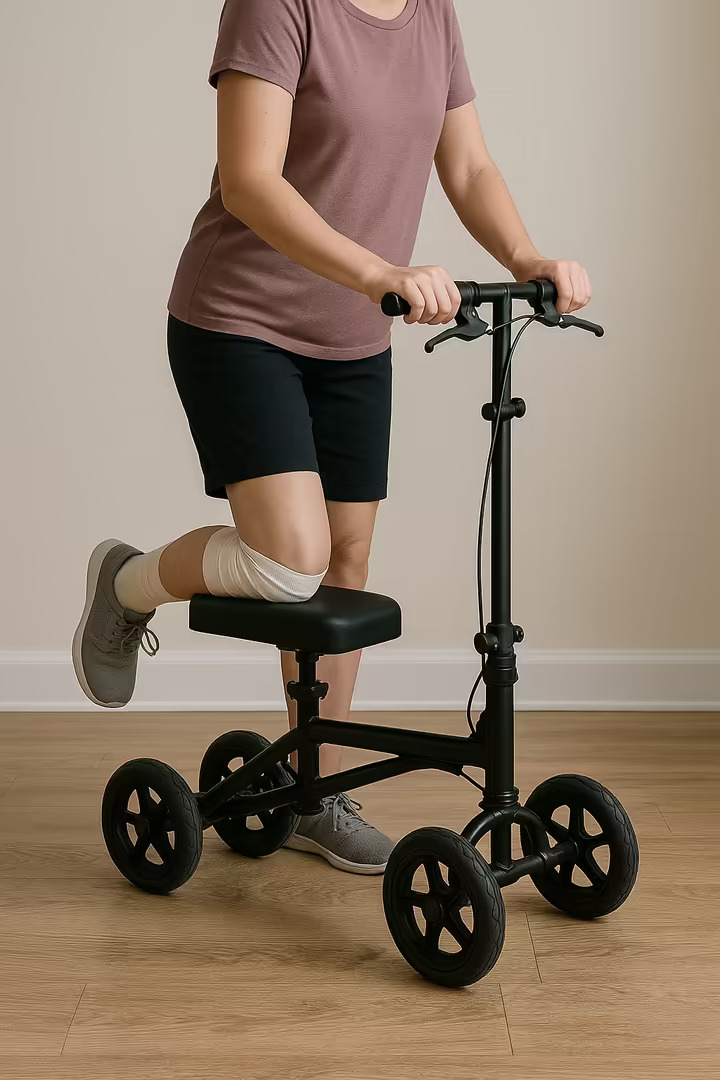
- Indications: Its use is strictly for temporary, unilateral, non-weight-bearing injuries below the knee , like an ankle fracture, foot surgery, or Achilles tendon rupture. 23 It allows hands-free mobility, an advantage over crutches.
- Contraindications: A knee walker is unsuitable for anyone with balance problems, general weakness, hip or knee pain on the standing leg, or bilateral injuries. It needs significant strength and balance in the unaffected leg to propel and control safely. 64
Canes, Crutches, Hemi-Walkers, Wheelchairs, and Scooters: Other Options
- Canes (Single-point or Quad): Good for those needing only minimal balance support or a tactile cue for positioning. A quad cane offers a wider, more stable base than a single-point cane but can be awkward. 27
- Hemi-Walker: A one-handed device providing a wider support base than a quad cane. It's the go-to for individuals with significant one-sided weakness (hemiparesis), such as after a stroke. 22
- Crutches: Used to offload weight from one leg, typically by younger, stronger individuals with good coordination and upper body strength after an acute injury.
- Wheelchairs and Power Scooters: Prescribed when a person can't walk safely or functionally, even with a walker or cane. They are for mobility, not walking training. 5 Medicare guidelines require proof that a patient's mobility needs can't be met by a less supportive device like a walker before approving an in-home wheelchair. 5
Frequently Asked Questions (FAQ) About Rollator Safety
What are the main disadvantages of a rollator walker?
The main downsides include their relative instability compared to standard walkers and the risk of the device rolling away. They can also be bulky in tight spaces like bathrooms and hallways, and struggle on uneven terrain, stairs, and steep slopes.50 Furthermore, if misused with a stooped posture, they might contribute to back pain and muscle deconditioning.2
Is it true that using a walker can make my muscles weaker?
Yes, using any walker, including a rollator, can lead to muscle weakness if it's used improperly and encourages a bad walking pattern. Chronically leaning on the walker reduces the workload on your leg and core muscles, potentially leading to disuse atrophy over time.46
However, when used correctly under a physical therapist's guidance to maintain an upright posture and normal gait, a walker can be a tool to help you exercise safely and build strength.48
How much hand strength do I need for rollator brakes?
You need enough strength and dexterity to reliably and quickly squeeze the brake levers to slow down or stop, and to push them down to engage the parking lock. If you have painful arthritis or significant hand weakness, you might not be able to operate standard loop brakes safely.9
Some rollators offer alternative push-down brakes that might be easier for some. This must be assessed by a professional before you buy one.
Can I safely sit on any rollator walker?
No. Only sit on a rollator specifically equipped with a seat and backrest. Before sitting, ensure the rollator is on a flat, stable surface and the brakes are firmly locked.53
Never let someone push you while you're seated in the rollator; it's not a transport chair and can tip over easily.59
Checklist: Is a Rollator the Right Choice?
Use this checklist as a guide. If you answer "No" to any "Consider a Rollator If..." question or "Yes" to any "Reconsider/Consult a Professional If..." question, a rollator might not be safest. This isn't a substitute for professional evaluation.
| Consider a Rollator If... | Reconsider/Consult a Professional If... |
|---|---|
| Can you bear full weight on both legs? (Yes/No) | Do you have a doctor's order to limit weight on one leg? (Yes/No) |
| Is your primary need for help with balance and endurance, not weight support? (Yes/No) | Do you have a severe balance disorder, frequent dizziness, or vertigo? (Yes/No) |
| Can you consistently remember to use the brakes before sitting? (Yes/No) | Do you have memory loss, dementia, or confusion that affects safety? (Yes/No) |
| Is your hand strength sufficient to squeeze the brake levers firmly and quickly? (Yes/No) | Do you have severe arthritis, pain, or weakness in your hands or wrists? (Yes/No) |
| Do you have good strength and control in both arms to steer the device? (Yes/No) | Do you have weakness or paralysis in one arm (e.g., from a stroke)? (Yes/No) |
| Can you maintain an upright posture while walking? (Yes/No) | Do you have advanced Parkinson's with "freezing" of gait? (Yes/No) |
| Is your home environment relatively spacious with few obstacles or stairs? (Yes/No) | Does your home have many stairs, narrow hallways, or thick carpet? (Yes/No) |
Understanding Regulatory Standards & Access to Rollators
Rollators are regulated as Class I medical devices by the U.S. Food and Drug Administration (FDA). 67 The main international standard for their design and safety is ISO 11199-2:2021 .
This standard specifies requirements and testing for static stability, braking, structural strength, fatigue resistance, and manufacturer-provided info. 68 It ensures devices meeting the standard have passed tough safety and durability tests.
Regarding financial access, Medicare Part B covers rollators as Durable Medical Equipment (DME). However, coverage has strict criteria. The rollator must be medically necessary for use inside the home , not just for outdoor convenience. 6
To get coverage, a physician must do a face-to-face evaluation and provide detailed documents justifying why the patient's mobility needs can't be met with a cheaper alternative, like a standard walker or cane. 6 The patient must also get the device from a Medicare-approved supplier.
Conclusion: Making an Informed Mobility Choice
A rollator walker is a valuable tool that can greatly improve mobility and life quality for the right person. However, its seeming simplicity hides a complex interplay between the user's functional abilities and the device's mechanical demands.
The evidence clearly shows that for individuals with significant cognitive impairments, severe balance disorders, specific physical limits (like weight-bearing restrictions or one-sided weakness), or certain advanced medical conditions, a rollator isn't just unsuitable, it's dangerous.
The decision to use a rollator should shift from a consumer choice to a clinical prescription. This means a change where self-prescription is replaced by mandatory, thorough assessment by a qualified physical or occupational therapist. Such an evaluation, covering cognitive, perceptual, physical, and environmental factors, is the only reliable way to ensure the chosen mobility aid truly enhances safety and function, rather than creating new risks.
By prioritizing careful, individualized assessment and training, clinicians, patients, and caregivers can navigate mobility aid selection complexities and prevent avoidable harm from misusing this common device.
Medical Disclaimer
This report is for informational and educational purposes only and is not medical advice. The information here isn't a substitute for professional medical advice, diagnosis, or treatment.
Always seek your physician, physical therapist, occupational therapist, or other qualified health provider's advice with any questions about a medical condition or selecting and using a mobility aid. Never ignore professional medical advice or delay seeking it because of something you read here.
Works cited
- Development, reliability and validity of the Safe Use of Mobility Aids ..., https://pmc.ncbi.nlm.nih.gov/articles/PMC7659047/
- Pilot study evaluating fear of falling and falls among older rolling walker users, https://www.researchgate.net/publication/272452910_Pilot_study_evaluating_fear_of_falling_and_falls_among_older_rolling_walker_users
- Walking with rollator: a systematic review of gait parameters in older ..., https://pmc.ncbi.nlm.nih.gov/articles/PMC6734589/
- Understanding the Relationship Between Walking Aids and Falls in Older Adults: A Prospective Cohort Study - ResearchGate, https://www.researchgate.net/publication/270962450_Understanding_the_Relationship_Between_Walking_Aids_and_Falls_in_Older_Adults_A_Prospective_Cohort_Study
- A Primary Care Provider's Guide to Wheelchair Prescription for Persons With Spinal Cord Injury - PMC, https://pmc.ncbi.nlm.nih.gov/articles/PMC7384540/
- Does Medicare Cover Rollator Walkers? | Solace, https://www.solace.health/articles/does-medicare-cover-rollator-walkers
- What documentation is required for Medicare to approve a rollator walker for a patient with osteoarthritis (Degenerative Joint Disease) of the knees and hip, currently requiring a cane for ambulation? - Dr.Oracle AI, https://www.droracle.ai/articles/103058/appropriate-documentation-for-medicare-to-approve-rolator-walker-for-patient-w-osteoarthritis-of-knees-and-hip-and-currently-needing-a-cane-to-ambulate-
- The effect of first‐time 4‐wheeled walker use on the gait of younger and older adults - DOI, https://doi.org/10.1002/pmrj.12700
- Who Should Not Use a Rollator Walker? 5 reasons to be cautious! - Mobility Heaven, https://mobilityheaven.com/who-should-not-use-a-rollator-walker/
- Who should not use a rollator walker? - Elenker, https://www.elenkerwalker.com/blogs/rollator-walkers/who-should-not-use-a-rollator-walker
- How to Choose the Best Rolling Walker (aka Rollator) - Rehabmart.com, https://www.rehabmart.com/post/how-to-choose-the-best-rolling-walker-aka-rollator
- A Caregiver's Checklist For Choosing A Rollator Walker - Trualta, https://www.trualta.com/resources/blog/the-ultimate-caregivers-checklist-for-choosing-a-rollator-walker/
- When You Need a Walker or Rollator | The Mobility Aids Centre Ltd, https://www.themobilityaidscentre.co.uk/blog/when-you-need-a-walker-or-rollator/
- How to Choose the Best Walker or Rollator for Your Patient | Performance Health, https://www.performancehealth.com/articles/how-to-choose-the-best-walker-or-rollator-for-your-patient
- The Potential for Effect of a Six-Week Training Program for Gait Aid Use in Older People with Dementia with Unsteadiness of Gait: A Pilot Study - MDPI, https://www.mdpi.com/2077-0383/12/4/1574
- Full article: The usability of rollators as part of the human-centred quality of mobility devices: a systematic narrative literature review, https://www.tandfonline.com/doi/full/10.1080/17483107.2024.2368651
- Effects of a rollator on fall prevention in Community-Dwelling people ..., https://pmc.ncbi.nlm.nih.gov/articles/PMC9984883/
- Quality Toolkit | AOTA, https://www.aota.org/practice/practice-essentials/quality/quality-toolkit
- (PDF) Walking with rollator: A systematic review of gait parameters in older persons, https://www.researchgate.net/publication/335727009_Walking_with_rollator_A_systematic_review_of_gait_parameters_in_older_persons
- Gait, Balance, and Fall Prevention - PMC, https://pmc.ncbi.nlm.nih.gov/articles/PMC3116773/
- Fall Prevention: Risk Assessment and Management for ... - Gov.bc.ca, https://www2.gov.bc.ca/assets/gov/health/practitioner-pro/bc-guidelines/fall_prevention_guideline_final.pdf
- Occupational Functioning: Physical Disabilities (Neuro) Days 6–9 - Jones & Bartlett Learning, http://samples.jbpub.com/9781284072358/9781284133622_CH10_DiZazzoMiller1e.pdf
- Tips for choosing and using walkers - Mayo Clinic, https://www.mayoclinic.org/healthy-lifestyle/healthy-aging/in-depth/walker/art-20546805
- Easy Steps to Fix Walker Brakes: A Complete Guide - VOCIC.com, https://vocic.com/blogs/news-and-blogs/how-to-repair-walker-brakes
- How to Adjust Walker Brakes Easily: DIY Guide | Because Market, https://becausemarket.com/blogs/news/how-to-lock-brakes-on-walker
- hand grip strength: Topics by Science.gov, https://www.science.gov/topicpages/h/hand+grip+strength
- Geriatric PT: Adaptive Equipment Essentials - Number Analytics, https://www.numberanalytics.com/blog/geriatric-pt-adaptive-equipment-essentials
- NBCOT - Question of the Day 2024 Flashcards - Quizlet, https://quizlet.com/907569338/nbcot-question-of-the-day-2024-flash-cards/
- Pathophysiology of Motor Dysfunction in Parkinson's Disease as the Rationale for Drug Treatment and Rehabilitation - PMC - PubMed Central, https://pmc.ncbi.nlm.nih.gov/articles/PMC4913065/
- Tackling freezing of gait in Parkinson's disease - Radboud Repository, https://repository.ubn.ru.nl/bitstream/2066/93606/1/93605.pdf
- (PDF) Freezing of gait: A practical approach to management - ResearchGate, https://www.researchgate.net/publication/277137947_Freezing_of_gait_A_practical_approach_to_management
- Assistive Devices for Personal Mobility in Parkinson's Disease: A Systematic Review of the Literature - PubMed, https://pubmed.ncbi.nlm.nih.gov/36339311/
- Treadmill training and body weight support for walking after stroke - PMC - PubMed Central, https://pmc.ncbi.nlm.nih.gov/articles/PMC6464779/
- Walking for hypertension - PMC - PubMed Central, https://pmc.ncbi.nlm.nih.gov/articles/PMC8128358/
- Treadmill training and body weight support for walking after stroke (Review) - ResearchGate, https://www.researchgate.net/profile/Jan_Mehrholz/publication/259883361_Treadmill_training_and_body_weight_support_for_walking_after_stroke/links/59e60d09a6fdcc1b1d970972/Treadmill-training-and-body-weight-support-for-walking-after-stroke.pdf
- Parkinson Disease and Orthostatic Hypotension in the Elderly: Recognition and Management of Risk Factors for Falls - PubMed Central, https://pmc.ncbi.nlm.nih.gov/articles/PMC7220277/
- (PDF) Parkinson Disease and Orthostatic Hypotension in the Elderly: Recognition and Management of Risk Factors for Falls - ResearchGate, https://www.researchgate.net/publication/341486176_Parkinson_Disease_and_Orthostatic_Hypotension_in_the_Elderly_Recognition_and_Management_of_Risk_Factors_for_Falls
- Orthostatic Hypotension in Older and Medically Complex Patients ..., https://www.medscape.com/viewarticle/759996_10
- Baby Walkers Guidelines - OMB 3041-0029, https://omb.report/icr/201307-3041-001/doc/40937101
- Baby Walkers: A Dangerous Choice - HealthyChildren.org, https://www.healthychildren.org/English/safety-prevention/at-home/Pages/baby-walkers-a-dangerous-choice.aspx
- How to Choose the Best Pediatric Walker - Pedistat, https://www.pedistat.com/blog/how-to-choose-the-best-pediatric-walker
- Types of Walkers - Together by St. Jude™, https://together.stjude.org/en-us/medical-care/rehabilitation/types-of-walkers.html
- Durable Medical Equipment (DME): Other DME Equipment (dura other), https://mcweb.apps.prd.cammis.medi-cal.ca.gov/file/manual?fn=duraother.pdf
- The use and perception of support walkers for children with disabilities: a United Kingdom survey - PMC, https://pmc.ncbi.nlm.nih.gov/articles/PMC7672809/
- Risks and Health Considerations for Rollator Walker Users - Elenker, https://www.elenkerwalker.com/blogs/rollator-walkers/risks-and-health-considerations-for-rollator-walker-users
- Walking Aids - Physiopedia, https://www.physio-pedia.com/Walking_Aids
- HANDLE‐HEIGHT ADJUSTMENT EFFECTS ON GAIT KINETICS IN OLDER ADULTS WHILE WALKING WITH A ROLLATOR A DISSERTATIO, https://twu-ir.tdl.org/bitstreams/de5325d0-9ef5-4c87-a3b2-743b6e4880c9/download
- Overcoming Challenges with Post Surgical Mobility: Assistive ..., https://keywaymedical.com/overcoming-challenges-with-post-surgical-mobility-assistive-solutions-for-recovery/
- The effects of walking aids on shoulder joint kinematics in older persons: an initial study, https://pmc.ncbi.nlm.nih.gov/articles/PMC10648336/
- How to choose the right assistive device for your needs | Blog - St. James Rehabilitation and Healthcare Center, https://www.stjamesrehab.com/blog/how-to-choose-the-right-assistive-device-for-your-needs
- Walkers for Seniors - HumanCare NY, https://www.humancareny.com/blog/walkers-for-seniors
- Choosing Between a Rollator and a Walker: Key Differences Explained - Transfer Master, https://transfermaster.com/blog/rollator-vs-walker/
- Safety information leaflet: four wheeled rollators - Oxford Health NHS Foundation Trust, https://www.oxfordhealth.nhs.uk/wp-content/uploads/2014/08/OP-101.15-Safety-information-leaflet-four-wheeled-rollators.pdf
- Walkers and Rollators what you need to know - Harmony Home Medical, https://harmonyhomemedical.com/pages/types-of-walkers
- Walking Aids - MiVam, https://www.mivam.com/wp-content/uploads/2019/02/katalog_2012_vp_za_gibanje_in_premikanje.pdf
- How to Tighten Rollator Brakes: Step-by-Step Guide - OasisSpace, https://www.oasisspace.com/blogs/healthcare/tighten-rollator-brakes
- Rollator-Brake-Instructions.pdf - Able Life Solutions, https://ablelifesolutions.com/wp-content/uploads/2019/11/Rollator-Brake-Instructions.pdf
- MAUDE Adverse Event Report: DRIVE MEDICAL CANADA, INC. ROLLATOR; WALKER, MECHANICAL - accessdata.fda.gov, https://www.accessdata.fda.gov/scripts/cdrh/cfdocs/cfmaude/detail.cfm?mdrfoi__id=12302519&pc=ITJ
- Is it safe to use a rollator walker as a wheelchair?, https://www.skdmedical.com/news/is-it-safe-to-use-a-rollator-walker-as-a-wheelchair
- An Occupational Therapist's Guide to Seat Walkers | HubSpot, https://cdn2.hubspot.net/hubfs/6041546/Whitepaper%20PDFs%20(Oct%202019)/An%20Occupational%20Therapists%20Guide%20to%20Seat%20Walkers.pdf?hsCtaTracking=7d03d4da-6bb0-4105-91af-39a32c19b316%7C2a7e7c87-be60-4c74-8a51-8fe4c593c565
- Rollator Safety | Brandon, FL | Dunedin, FL, https://www.andersonhomemedical.com/blog/rollator-safety-tips
- How to Walk With a Walker - Ultimate Care NY, https://www.ultimatecareny.com/resources/how-to-walk-with-a-walker
- The Effects of Structural Characteristics of the Rollator on the Elderly's Gait Strategies in Various Walking Environments - MDPI, https://www.mdpi.com/2076-3417/13/19/11044
- Whats the Difference Between a Knee Scooter and a Knee Walker, https://www.rentakneewalker.com/stories/whats-the-difference-between-knee-scooter-and-knee-walker
- PATIENT EDUCATION AND INSTRUCTION BOOKLET COMBINED 01 2023, https://cdnmedia.endeavorsuite.com/images/organizations/3679c277-926f-478c-94f3-afbc44f2d3c9/PDFs/PATIENT_EDUCATION_AND_INSTRUCTION_BOOKLET_COMBINED_01_2023.pdf
- How To Use a Walker - Cleveland Clinic, https://my.clevelandclinic.org/health/procedures/how-to-use-a-walker
- MAUDE Adverse Event Report: MEDLINE INDUSTRIES INC.; ROLLATOR,LUXE,WHITE, https://www.accessdata.fda.gov/scripts/cdrh/cfdocs/cfmaude/detail.cfm?mdrfoi__id=8712378&pc=ITJ
- ت صدر عن وزارة اإلإعالم مملكة البحرين, https://www.lloc.gov.bh/OG/3782A.pdf
- CE Certification and Testing Laboray for Walking Aids | JJR - JJR LAB, https://www.jjrlab.com/news/ce-certification-and-testing-laboray-for-walking-aids.html
- EN ISO 11199-2:2021 - Assistive products for walking manipulated by both arms - Requirements and - iTeh Standards, https://standards.iteh.ai/catalog/standards/cen/d2b7f1af-b3ce-4cbf-af90-a77ca418ef81/en-iso-11199-2-2021
- Rollator Walkers: Medicare Coverage Guide - Healthline, https://www.healthline.com/health/medicare/medicare-criteria-for-rollator-walker